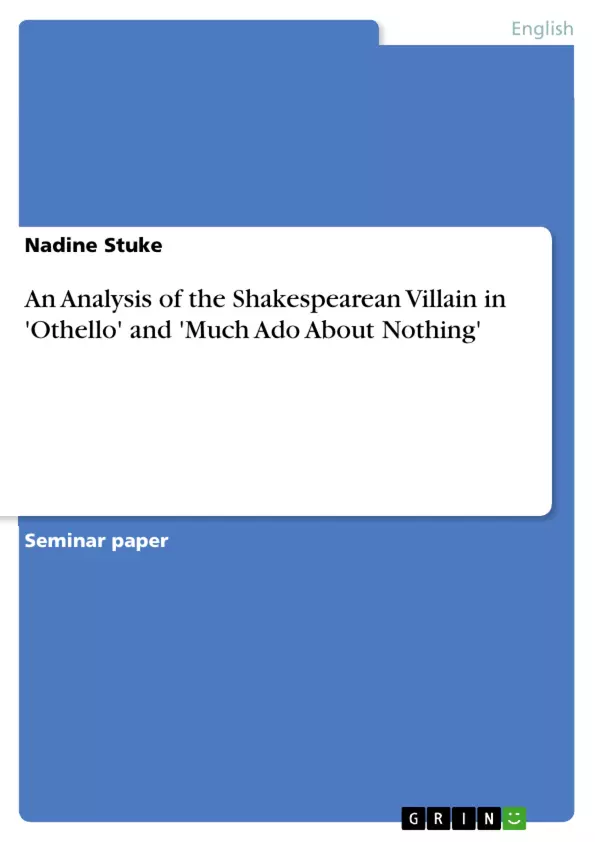Is there a difference between a tragic villain and a comic one? On the basis of the two Shaespearean villains Iago of the tragedy Othello and Don John, the villain of the comedy Much Ado about Nothing this term paper aims at scrutinizing the concept of the Elizabethan villain.
Table of Contents
- 1. Introduction
- 2. Tragedy, Comedy and the Elizabethan Villain
- 2.1. Tragedy
- 2.2. Comedy
- 2.3. The Elizabethan Villain
- 3. Comparison Between the two Different Villains
- 3.1. The Tragic Villain: Iago
- 3.2. The Comic Villain: Don John
- 4. Conclusion
Objectives and Key Themes
This term paper aims to analyze the differences between tragic and comic villains in Shakespearean plays. It examines the characteristics, motives, and strategies of Iago (Othello) and Don John (Much Ado About Nothing) to highlight the contrasting roles of villains within different dramatic genres.
- The definition and conventions of tragedy and comedy in Elizabethan drama.
- The characteristics and function of the Elizabethan villain.
- A comparative analysis of Iago's and Don John's villainous traits.
- The exploration of the motives behind their actions.
- The contrast between tragic and comic resolution in relation to the villain's role.
Chapter Summaries
1. Introduction: This introductory chapter sets the stage for the paper by highlighting Shakespeare's enduring impact on literature and theatre. It introduces the concept of the Shakespearean villain as a significant dramatic element and establishes the central question: What is the connection between the complexity of a villain's character and the genre in which it appears? The chapter then outlines the paper's focus on comparing the tragic villain Iago from Othello and the comic villain Don John from Much Ado About Nothing, emphasizing the analysis of character traits, motives, and strategies.
2. Tragedy, Comedy and the Elizabethan Villain: This chapter provides a foundational understanding of tragedy and comedy within the Elizabethan context. It begins by acknowledging the complexities inherent in defining tragedy, referencing Aristotle's concept of mimesis and the tragic hero's downfall, including the idea of a tragic flaw. The chapter contrasts this with comedy, focusing on its intellectual rather than emotional response, its use of stereotypical characters, and its characteristic happy ending often involving marriage. Finally, it establishes the defining traits of the Elizabethan villain in general terms, setting the framework for the comparison of Iago and Don John in subsequent chapters.
Keywords
Shakespeare, Elizabethan drama, tragedy, comedy, villain, Iago, Othello, Don John, Much Ado About Nothing, tragic villain, comic villain, character analysis, dramatic genre, motives, strategies.
Frequently Asked Questions: A Comparative Analysis of Tragic and Comic Villains in Shakespeare
What is the main topic of this academic paper?
This paper analyzes the differences between tragic and comic villains in Shakespearean plays, specifically comparing Iago from Othello (tragic villain) and Don John from Much Ado About Nothing (comic villain). The analysis focuses on their characteristics, motives, strategies, and the contrasting roles of villains within different dramatic genres.
What are the key themes explored in the paper?
Key themes include the definitions and conventions of Elizabethan tragedy and comedy, the characteristics and function of the Elizabethan villain, a comparative analysis of Iago and Don John's villainous traits, exploration of their motives, and the contrast between tragic and comic resolutions in relation to the villain's role.
Which Shakespearean plays are analyzed in this paper?
The paper focuses on two Shakespearean plays: Othello and Much Ado About Nothing. It uses Iago (Othello) as an example of a tragic villain and Don John (Much Ado About Nothing) as an example of a comic villain.
What is the structure of the paper?
The paper is structured as follows: an introduction setting the context and outlining the central question; a chapter defining Elizabethan tragedy, comedy, and the villain; a comparative analysis of Iago and Don John; and a conclusion. A table of contents provides a detailed overview of the chapters and sub-sections.
What are the objectives of this academic paper?
The paper aims to demonstrate the differences between tragic and comic villains in Shakespeare by analyzing the specific examples of Iago and Don John. It seeks to highlight how the villain's character complexity relates to the genre of the play.
What are the key characteristics of Elizabethan tragedy and comedy as discussed in this paper?
The paper explores the defining features of Elizabethan tragedy, referencing Aristotle's concept of mimesis and the tragic hero's downfall, including a tragic flaw. Comedy is contrasted, focusing on its intellectual rather than emotional response, stereotypical characters, and its characteristic happy ending.
How does the paper define the Elizabethan villain?
The paper establishes the defining traits of the Elizabethan villain in general terms, providing a framework for comparing Iago and Don John. This allows for a clearer understanding of how these villains fit within the broader context of Elizabethan dramatic conventions.
What keywords are associated with this academic paper?
Keywords include Shakespeare, Elizabethan drama, tragedy, comedy, villain, Iago, Othello, Don John, Much Ado About Nothing, tragic villain, comic villain, character analysis, dramatic genre, motives, and strategies.
What is the intended audience for this paper?
The paper is intended for an academic audience interested in Shakespearean drama, character analysis, and the conventions of Elizabethan tragedy and comedy. The language and structure suggest a scholarly approach suitable for university-level study.
Where can I find chapter summaries for this academic paper?
The provided HTML includes chapter summaries for the introduction and the chapter on Tragedy, Comedy, and the Elizabethan Villain. These summaries provide an overview of the content covered in each chapter.
- Citation du texte
- Nadine Stuke (Auteur), 2010, An Analysis of the Shakespearean Villain in 'Othello' and 'Much Ado About Nothing', Munich, GRIN Verlag, https://www.grin.com/document/191486



